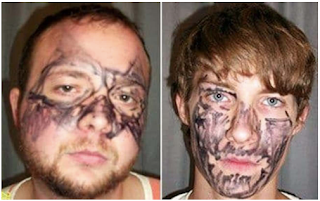The master of disguise is a trope that has dwindled in use recently. That’s unfortunate because the idea of disguising oneself to evade, deceive, or control is RICH with dramatic potential. Indeed humanity’s fascination with disguises date back to our cave-dwelling ancestors who wore masks in ceremonies, performances, and in battle. That latter-most of which we still do to this day.
The disuse of disguises in contemporary fiction is due largely to misconception of what a disguise is. Most of us think of elaborate wigs, fake teeth, goofy noses, and other gag-store gimmicks. The send up of all of these have been comedic GOLD. If you doubt me, check out any of Peter Sellers’ Pink Panther films. Avoid all of the knock-offs.
While Robert Downey Jr.’s Sherlock does employ disguises to great effect, the Richie films still depict disguises with a wink to the camera and a nudge to the audience. So has there ever been a successful use of a total disguise? Weeeeell…
In 1853 English officer Richard F. Burton made the "forbidden" passage to Mecca. Initially disguised as a Pershian prince, Burton had to discard that cover after a night of raucous drinking with English soldiers at one stop on the journey. Ultimately, Burton settled on the “role” of Abdallah the Hajji or Abdallah the pilgrim. He sold his book as the first whtie man to make the passage to Mecca.
There are two ironies immediately apparent here. First: Burton was no master of disguise. The faithful who made the passage—many whom had never been out of their village—accepted everyone. Who the hell looks “out of place,” when EVERYONE is out of place? Second: Burton ultimately converted to the Islamic faith and could’ve made the passage to Mecca honestly. Indeed, the pilgrimage is NOT forbidden based on skin color. It is restricted, (based on on practical logistics) to the faithful.
As you can see Burton really "stretched" for this disguise.
Also, people’s faith and cultural identity is not an amusement park.
But for every Richard F. Burton, there are two morons who attempt to disguise themselves for a burglary…with permanent marker. By the way, that went as well as you might expect. Jokes, (sorta) aside, the difference between success and failure is one-part luck and six-parts context.
A woman on her way to make a deposit saw a man in a car putting on a wig and sunglasses. Honestly, how often do you see someone put on a wig in a bank parking lot—even if you’re in the trade? She called the cops and the infamous Polo Shirt Bandit was undone.
During WWII, 76 men escaped Stalag Luft III. Truly, a great escape, the men had learned conversational German. They had forged travel documents, complete with photographs. They even modified their uniforms to look like civilian clothing. Still, 73 were recaptured. One initially evaded capture by successfully answering questions from a German officer—only for the officer to order his arrest. What gave him away? He was wearing the same distinct shirt from his I.D. photo. The officer told him, “that never happens.”
Ultimately, context worked against the Stalag Luft III escapees. They looked out of place to people looking for men out of place.
So what does success look like?
William Guess did successfully rob nearly a dozen banks before he was observed donning his wig and sunglasses on that fateful November day. Wilhelm Voigt cobbled together a German Officer’s uniform, (modified from used clothes bought for their color) commandeered two squads of soldiers, (who simply saw an old fart in a captain’s uniform) and took control of the Kopenick town hall. His ultimate goals are debatable but Voigt did get away with the cash box and 4000 Deutsch marks, (about $50,000 today).
Again, context is key. Richard F. Burton dressed as a dervish pilgrim will NEVER be confused for a German officer. But Willie Sutton—arriving at a bank dressed as a Western Union messenger, or a cop, or window washer—robbed DOZENS of banks stealing over $2MM from the 1920s to the 1950s.
“Oh, that would never happen today,” you say?
In 2005, death-row inmate Charles Victor Thompson escaped from a Harris County courthouse dressed as an attorney, complete with forged Texas Attorney General identification.
Police seen a white man in a tie with an official (-ish) ID and let the man with that haircut walk free.
Who gets it right in fiction: Robert Ludlum’s spies change the part in their hair, sometimes they change their hair color, and use contacts to change eye color. As previously demonstrated, it doesn’t take much. Context is more important than fake mustasches. Gillian Flynn’s Amy Dunne cuts her long blond hair, dies it drab-brown, and stops wearing makeup. The transformation is described as drastic because it is.
Basic changes - context clues = drastic results. Yeah, I know. If we wanted to do math we wouldn't have gone into writing. Key takeaway: when in doubt for your brilliant spy, assassin, or big bad, just remember—less really is more.
The photo at the top: Fletch movie poster, is the property of Universal Pictures. The photo at the bottom, Charles Victor Thompson, fugutive photo is the property of the U.S. Marshal Service. The photo of the marker guys is the property of the Carroll, IL police department. All are used for educational/illustrative purposes as covered by the Fair Use Doctrine. The photos/artist rendering of Richard F. Burton, (a.k.a. Abdallah the Hajji) creators unknown, are in the public domain.







No comments:
Post a Comment